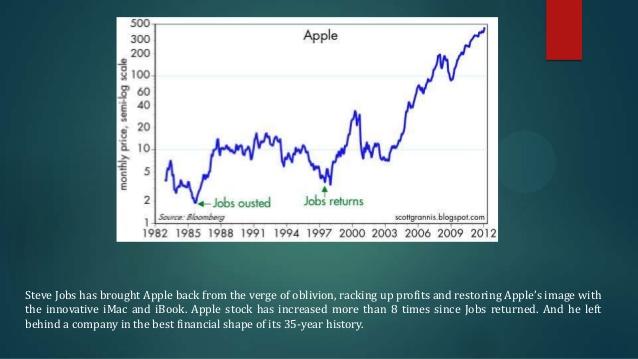Abstract
Steve Jobs was born in 1955 in California. Although he dropped out of college after some time, Steve Jobs never gave up pursuing his dreams in life. He was the brainchild behind Apple-One computer. After convincing Steve Woz, the two entrepreneurs embarked on a long journey of manufacturing unique personal computers. Jobs was very keen on establishing a computer manufacturing company. The innovative nature of Jobs enabled the company to return to profitability. He spearheaded several projects within the industry. Apple Inc. experienced a rapid phase of expansion and profitability under Job’s watch
Steve Jobs leadership style & personality
Some of the main elements of his leadership style included effective communication, involvement, innovation, risk-taking, passion, and focus. From 1977 to 1985, Apple was managed by six Chief Executive Officers (Finkle & Mallin, 2010). However, the company failed to attain technological zeal and marketing passion that is required for its growth. The company needed a CEO who would be in a position to skillfully and competently incorporate its marketing and technological needs (Nair & Leng, 2012). When Jobs joined the company, he was capable of identifying the much-needed marketing prism and the core company’s activities that would rapidly boost productivity (Isaacson, 2012). Within a very short time, he managed to revitalize the performance of the company. He attained the latter by focusing on the needs of consumers and developing tailor-made products.
Steve Jobs: transformational leader
The leadership style of Steve Jobs was largely transformational. He sought to transform those under him so that they could perform better while discharging their roles. Through this type of leadership style, he imparted positive change to his subordinates. He equally applied his charismatic nature to motivate employees. As a transformational leader, he excelled very well in innovating new products for the company (Saxena, 2014).
He was also an unconventional leader. He never managed the company based on theoretical ideas published in books. He took a different and unique direction in his style of management and leadership. He was very blunt when criticizing members of staff. In other words, he never hid anything from the subordinates. Jobs demanded excellence in performance (Toma & Marinescu, 2013). The chart below shows how Steve Jobs worked smart to resuscitate the performance of Apple Inc.

Charismatic leadership
Initially, some critics of Steve Jobs thought that most of the internal challenges at Apple Inc. were being caused by his charismatic leadership style. However, this was not the case. His charisma led to an idealistic vision and brilliance towards innovation. He was very firm with is ideas that, at some point, he could not allow any opposition from the management board. Needless to say, this was an internal trait that could not just be pushed away easily.
Several leaders are endowed with the trait leadership model. The latter can be used to estimate or project the effectiveness of a leader. The probability of success or failure may be measured using the trait model, especially when two or more leaders are compared in terms of their performance (Allio, 2013).
There are outstanding personality traits, abilities, and interests among leaders who are deemed to be successful. In the case of Steve Jobs, his charismatic nature enabled him to improve the performance of Apple Inc. throughout the period when he was the CEO. However, it is vital to mention that the success rate of a leader cannot be established by the traits per se. Jobs demonstrated a high level of cognitive ability, self-confidence, honesty/integrity, leadership motivation, and achievement drive in order to expedite the performance of Apple Inc. He was also a flexible, creative, and emotionally mature leader.
The content theory of motivation presents the basic needs model. Jobs ensured that the needs of employees were met so that they could be productive (Roe, 2014).
A Model of Leader Attributes and Leader Performance was developed by Zaccaro to relate the effectiveness of leaders and their traits. Besides, Judge and colleagues developed the Leader Trait Emergence Effectiveness (LTEE) Model in order to expand previous models. The latter model introduced the aspect of genes in the development of leaders.
References
Allio, R. J. (2013). Leaders and leadership – many theories, but what advice is reliable? Strategy & Leadership, 41(1), 4-14. Web.
Finkle, T. A., & Mallin, M. L. (2010). Steve Jobs and Apple, Inc. Arden: Jordan Whitney Enterprises, Inc. Web.
Isaacson, W. (2012). The real leadership lessons of Steve Jobs. Harvard Business Review, 90, 92-100. Web.
Nair, P. B., & Leng, Q. A. (2012). The sweet and sour apple: The case of CEO strategies at apple inc. Vidwat, 5(1), 21-24. Web.
Roe, K. (2014). Leadership: Practice and Perspectives. New York: Oxford University Press. Web.
Saxena, S. (2014). What would Steve Jobs do? – How the Steve Jobs way can inspire anyone to think differently and win. South Asian Journal of Management, 21(1), 181-185. Web.
Toma, S. & Marinescu, P. (2013). Steve Jobs and modern leadership. Manager, (17), 260-269. Web.